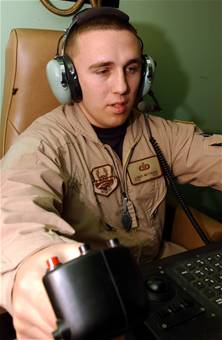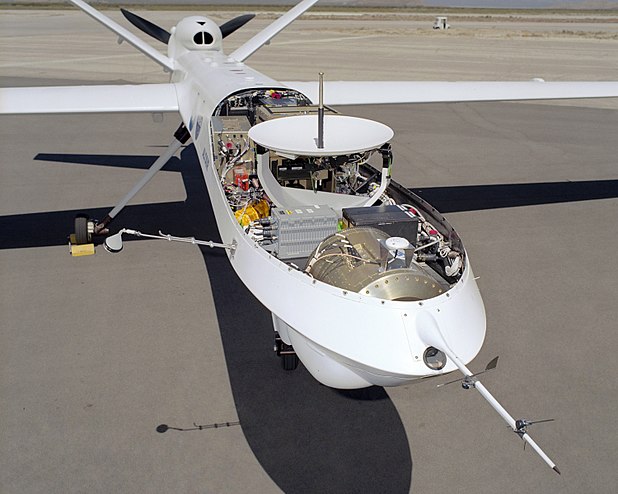


BALAD AIR BASE, Iraq — It looks more Star Wars than Iraq War, an unmanned aerial killer ready to fly its first combat mission in Iraq. But the MQ-9 Reaper is more than just a stunning sight — it may represent the future of combat aviation.
The Reaper's streamlined form stands out in its hangar in Balad Air Base in central Iraq, now the busiest in the world for the Department of Defense, with F-16s and cargo planes taking off and landing every few minutes.
The Reaper looks like its predecessor, the Predator drone, which was originally built as a reconnaissance plane and is already widely in use in Iraq and Afghanistan in support of troops on the ground.
But the Reaper was built with offense in mind. It can carry four Hellfire missiles (the Predator carries only two), and it is equipped with a pair of 500-pound laser-guided bombs.
• Click here to see exclusive video from the Reaper's first combat operations in Iraq.
The Reaper doesn't have to refuel as often as typical fighter jets, so it can stay airborne longer and be involved in even more combat.
Thanks to its turboprop engine and advanced sensors, the Reaper can fly twice as fast and reach much higher altitudes than the Predator. And it doesn't miss much on the ground — even from miles above.
Related
*
Stories
o NASA, Air Force Drones to Fly Over Fire Zone
"It's got infrared, so you can actually see somebody smoking a cigarette from about 25,000 feet," said Maj. Jon Chesser, a Reaper pilot attached to the 46th Expeditionary and Reconnaissance Attack Squadron.
But Chesser doesn't pilot the Reaper from inside. Instead, he operates the drone from a cockpit in a reinforced trailer on the ground at Joint Base Balad. The joystick he uses to control the plane looks remarkably like a computer game control.
The Reaper is slated to take over many support missions for ground troops next year that are currently being flown by F-16 fighter jets.
And while some of the Air Force’s most experienced pilots will be missing takeoffs and landings during missions, they aren’t getting replaced by machines yet. Some pilots say operating a Reaper is as intense as being up in the air.
"When I first came out and realized I was I going to fly Predators and Reapers, I was a little disappointed, but once I started flying and realizing the cutting-edge technology and the types of missions I was going to be flying, it's exciting," said Lt. Col. Micah Morgan, who commands the squadron.
"The adrenaline and everything is exactly the same as you would get in a Strike Eagle or F-16 — your blood pressure goes up, your heart rate increases," said Major Chesser. "You're there to support the guys on the ground, you're hoping you are helping them out. You have a sense of urgency just like you would in a fighter."
For now the Reaper is being used principally as a weapons platform to attack ground targets; it can't yet do everything an F-16 with a human pilot can do, such as engage in aerial combat.
But some of the pilots describe the introduction of the Reaper as the start of a dramatic change in aeronautics, one that will significantly alter the way wars are waged from the air.






 http://www.strategypage.com/htmw/htairfo/articles/20080811.aspx
http://www.strategypage.com/htmw/htairfo/articles/20080811.aspxThe Rise Of The Droids
August 11, 2008: The U.S. Air Force is, for the first time, converting a fighter wing from manned (F-16) combat aircraft, to unmanned ones (the MQ-9 Reaper.) The conversion, for the 174th Fighter Wing, has been in the works for three years, and the last combat sorties in manned aircraft were flown last week, by members of the 174th serving in Iraq.
The air force has already converted several combat wings to fly Predators which, while armed (with two 107 pound Hellfire missiles), are considered reconnaissance aircraft. The Reaper is considered a combat aircraft, optimized for seeking out and destroying ground targets. Jet powered combat UAVs are in development. It's only a matter of time before UAVs take over air superiority, strategic bombing and suppression of enemy air defenses duties as well.
Strafing and "intimidation" (coming in low and fast) attacks have been very useful in Iraq and Afghanistan, so the Reaper is not going to put the F-16s out of business right away. But the 19 ton F-16 costs three times as much as a Reaper, and is much more expensive to operate. The F-16 uses over a hundred times more fuel, per hour in the air, and with the price of oil rapidly rising, that itself means a lot. Put simply, It's cheaper, more effective, and safer (for pilots) to use Reapers (or similar aircraft) for a lot of the ground support work. Fighters are still needed to keep the skies clear of enemy aircraft, although Reapers are better suited for the dangerous work of destroying enemy air defenses. But for fighting irregulars, the Reaper is king.
The MQ-9s cost has doubled in the last few years, to about $18 million per aircraft (with all the high end sensors). The 4.7 ton Reaper has a wingspan of 66 feet and a payload of 1.5 tons. Reaper is considered a combat aircraft, because it can carry everything from the hundred pound Hellfire missile, to the 500 pound laser or GPS guided smart bomb. Reaper has a laser designator, as well as day and night (infrared) cameras. Reaper can stay in the air for over 14 hours and operate at up to 50,000 feet. It's sensors have excellent resolution, and are effective at high altitudes. It's been noted that most of what F-16s (and F-18s) are doing these days is dropping smart bombs, and using their targeting pods to do recon for the ground troops. Reaper does both of these jobs better and cheaper.
The major advantage of the Reaper is it's "persistence." It can stay in the air for 14 hours (or more), and that means you can put it over an area of interest, and wait for the enemy to do something. If that happens, the Reaper is there with Hellfire missiles and smart bombs. The Reaper had two heavyweight (up to 1,500 pounds) inboard (close to the fuselage) hard points for bombs and missiles, and four more (two up to 600 pounds, and two up to 200 pounds) outboard (farther out on the wing). A max of 3,000 pounds of bombs and missiles can be carried on these hard points. Thus one Reaper can fly out with over a ton of munitions, and stay out for over ten hours. An F-16 can do that, but only if you want to wear down the pilot. The Reaper operators work in shifts, and are in much better shape to handle whatever comes up.
Reapers have only been in combat for a year, but for the troops on the ground, and many of those operating these UAVs, the future has arrived. While the pilots of the 174th Fighter Wing will miss flying jets, as National Guard reservists, they can now do their active duty without leaving their families, and go live in a trailer over in Iraq or Afghanistan. The maintenance troops will still go overseas, although some of the UAV maintenance is being done by civilian contractors.




tons of cool pics here:
http://www.defensetech.org/archives/cat_drones.html